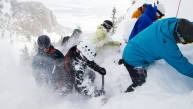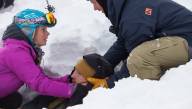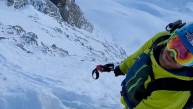tags:
Sage Cattabriga-Alosa |Ian McIntosh |Jeremy Jones |Dash Longe |Tim Durtschi |
zahan billimoria |utah |todd ligare |tim durtschi |tgr iprw |teton gravity research |snowboard |snowbird ut |ski mountaineering |ski |scotty pike |sage cattabriga-alosa |safety week 2014 |ryland bell |production |premium content |max hammer |live from the field |jeremy jones |iprw tgr |iprw |ian mcintosh |featured |dylan hood |dash longe |daniel tisi |dane tudor |company news |colter hinchliffe |colter hinchcliffe |big mountain |backcountry news |backcountry |angel collinson
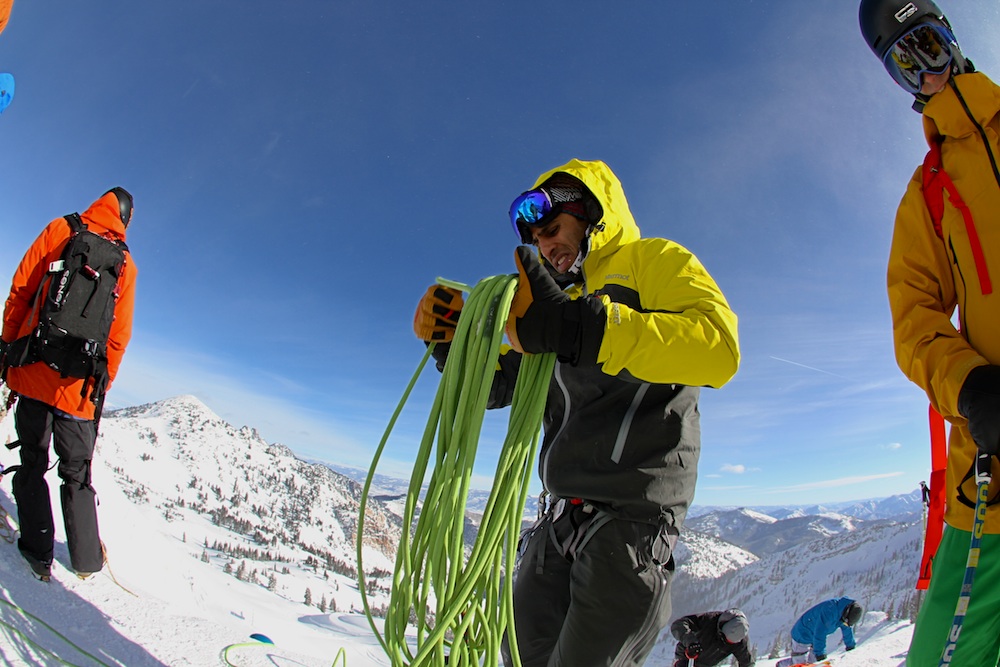
The 2013 International Pro Riders' Workshop, presented by Icedot.org, is an annual pioneering TGR event that develops safe mountain protocols for all of TGR's film athletes and cinematographers. On day one of the workshop, Exum Mountain Guide's Zahan Billimoria led a day-long clinic on using ropes while skiing in the mountains. Ryan Dunfee photo.
“Ultimately, what we’re trying to do is add layers of security to what we do using a very simple tool – a rope,” said Exum Mountain Guides’ Zahan “Z” Billimoria, who led the first day of rope skills training at TGR’s International Pro Riders’ Workshop presented by Icedot.org. “When you’re getting into really high angle terrain as a skier, if you look at it with a climber’s mindset, you’re basically free soloing. In other words, you’re just climbing without a rope. And people see climbers do that and think they’re crazy, but as skiers we’ve become very comfortable ‘free soloing’ because we never ski with a rope.’”
 The longest you'll ever get a crew of skiers and snowboarders to stand still inside... Ryan Dunfee photo
The longest you'll ever get a crew of skiers and snowboarders to stand still inside... Ryan Dunfee photo
TGR’s athletes and cinematographers are developing an increasing amount of rope skills for their work out in the field. You’ve no doubt seen Jeremy Jones rappelling down icy vertical couloirs, or guys like Griffin Post in Way Of Life using ice axes, crampons, harnesses, and ropes to summit backcountry peaks like the Middle Teton in order to crush a rowdy descent. Our crew has developed these skills not only to get up and down impossibly steep terrain, but also to safeguard against a slip in rocky no-fall terrain, to safely send someone out to look over the edge of an overhanging cornice or dig a snow pit on a questionable face, or simply for the piece of mind.
 Sage Cattabriga-Alosa watches Co-Lab star Nick McNutt put together a figure-eight knot. Ryan Dunfee photo.
Sage Cattabriga-Alosa watches Co-Lab star Nick McNutt put together a figure-eight knot. Ryan Dunfee photo.
“My observation is that the skier’s mentality is that ropes come into play when disaster strikes,” Z said. “And so when you ask somebody about using ropes, it’s about extricating somebody out of a crevasse, or building a mechanical advantage system to drag a sled out of a trough or whatever. But I’m trying to break that mentality and say, “Listen, let’s use that rope preventatively in really high consequence terrain in which a slip could be catastrophic. If you’re carrying the rope already in case things might go wrong, why not use it to prevent them from going wrong in the first place? But always keeping in mind to keep things simple and light, because we’re skiers not climbers – the rope is a necessary thing that we might have to break out, but it’s not fun for us. It’s not why we’re here.”
 Zahan demonstrates a simple hip belay - good for lowering someone into low-angle terrain or out to check a cornice. Ryan Dunfee photo.
Zahan demonstrates a simple hip belay - good for lowering someone into low-angle terrain or out to check a cornice. Ryan Dunfee photo.

Jeremy is way stoked on the hip belay. Belay on to get Xtreme! Ryan Dunfee photo.
But while the emphasis is on keeping things quick and simple, the dynamicism of snow necessitates a huge range of technical rope skills. As Z puts it, in the climbing world rope systems are very black and white. For the most part, you’re always climbing vertically with one system. “Whereas skiing is way more dynamic because snow is this ephemeral, magical material that you blow on it and it disappears and in the summer it’s gone, and from the moment that flake hits the ground, it’s starting to metamorphose and change, and that ultimately dramatically affects the strength,” Z said. In frozen early-morning spring snow, you might be able to cut a bollard in the snow and rappel off of that, but in four inches of powder snow that same rope will just rip right out. “The strength of that snow can dramatically change over a day or over a week. And so it’s a really elastic system that is very complex. It requires constant adaptations and constant judgment calls. Every time I put a skier on the line and on belay, I’m making a pretty big judgment call. Sometimes you need to make a super complex three-piece anchor, and other times you simply assume a seated position in the snow and put a hip belay on and you’re good to go. It’s much more of an art, I think.”
 Jeremy Jones secures cinematographer Justin Fann with his signature ice axe anchor. Ryan Dunfee photo.
Jeremy Jones secures cinematographer Justin Fann with his signature ice axe anchor. Ryan Dunfee photo.
So over the course of the day in a roped-off Mineral Basin at Snowbird, athletes like Jeremy Jones and Ian McIntosh and cinematographers like Matty “Moo” Herringer and Nick Kalisz learned and practiced how to set up a simple hip belay with their butt and heels in the snow, how to tie the appropriate knots for different kinds of situations, how to belay straight up a rope from a crevasse, and even learned how to make an anchor that would hold a two hundred pound snowboarder out of a one-ounce stuff sack. “We’re trying to incrementally add layers of security with a rope that are appropriate to the load and the hazard.”
 Photographer Andrew Miller demonstrates the effectiveness of a simple snow sack filled with snow as an anchor. Ryan Dunfee photo.
Photographer Andrew Miller demonstrates the effectiveness of a simple snow sack filled with snow as an anchor. Ryan Dunfee photo.
Those who’ve seen the trailer for Higher or Way Of Life might have seen Z in the Tetons assisting Griffin Post, Max Hammer, Jeremy Jones, and Bryan Iguchi on some of the range’s biggest peaks, but he sees his role in those situations as less of a guide and more of a consultant. He provides knowledge when it comes to the snowpack, technical rope systems, and will lead on the way up, setting the route and the ropes so the athletes can conserve their energy for the descent. “But ultimately, when it’s go time, I get out of the way. I’m there to answer their questions or filter their thinking, but it’s ultimately up to them to match the mountain with their skillset. Their prowess on the mountain is so much higher than mine – their ability to ride that terrain is so far over my head, so it’d be insane for me to tell them it’s over their head.”
 Ian McIntosh belays Sage as he ascends a lift tower to practice extracting from a crevasse fall. Ryan Dunfee photo.
Ian McIntosh belays Sage as he ascends a lift tower to practice extracting from a crevasse fall. Ryan Dunfee photo.
But while Griffin or Jeremy’s skills on snow are on the next level, Z sees this set of skills in ski mountaineering and rope work as something that will allow people to take advantage of a truly attainable and amazing adventure. “People watch Griffin or Jeremy’s mountaineering descents and say wow! I knew I could never afford the all-expenses-paid heli ski trip to Alaska, but I sure as hell could afford a trip to Jackson where I go touring.” At the end of the day, the set of skills even TGR’s athletes are learning over the course of the International Pro Riders’ Workshop are simple and manageable for truly anyone – they just require a little bit of a time investment and maybe a few days in course like Exum’s Ski Mountaineering Clinic, which helps people understand and develop rope skills for a few days in non-consequential terrain. “It’s an adventure from the ground up,” said Z. “And people are going to feel the accomplishment of doing it all with their own two feet. I hear it all the time from the feedback from the Tetons segment, like ‘Oh my god – that’s possible! It’s relatable, and it’s so exciting. It’s a whole new world.’”
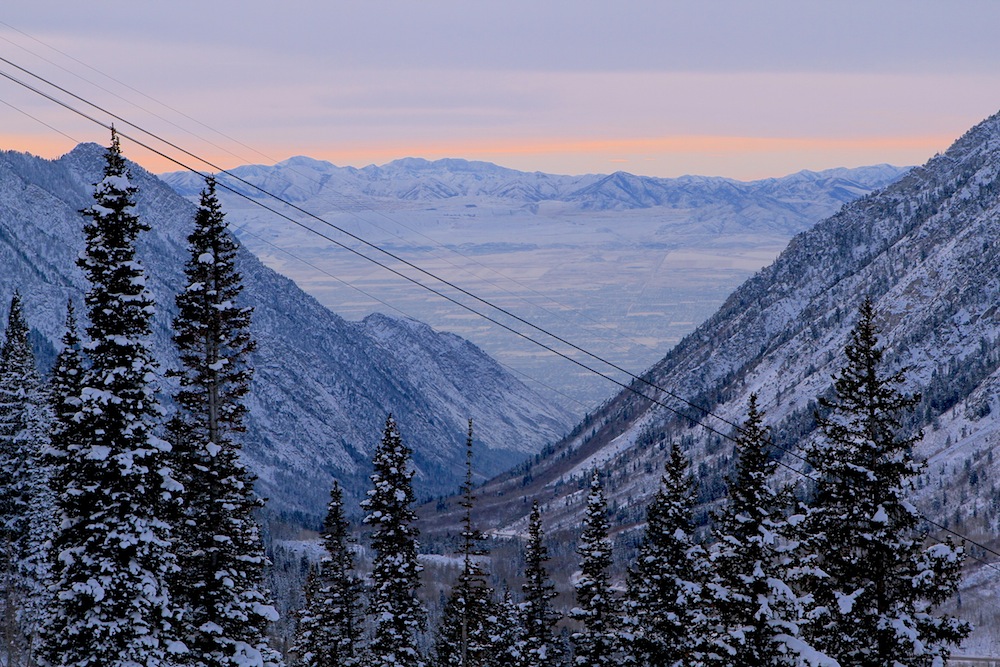 A beautiful view down Little Cottonwood Canyon to end a solid day developing skills in the mountains. Ryan Dunfee photo.
A beautiful view down Little Cottonwood Canyon to end a solid day developing skills in the mountains. Ryan Dunfee photo.



